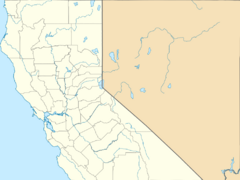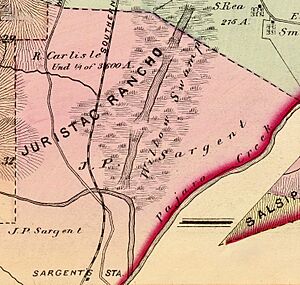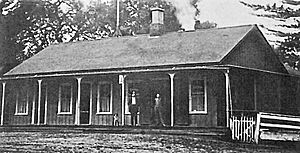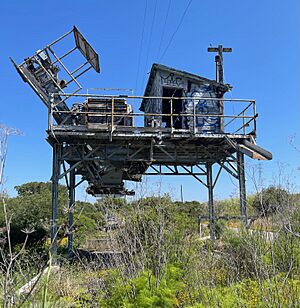Sargent, California facts for kids
Quick facts for kids
City of Sargent
|
|
|---|---|
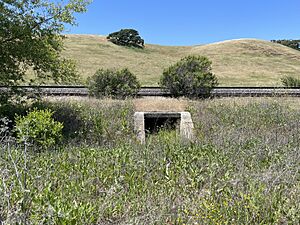
Sargent, California
|
|
| Country | United States |
| State | California |
| County | Santa Clara |
| Elevation | 144 ft (44 m) |
| Time zone | UTC−8 (Pacific (PST)) |
| • Summer (DST) | UTC−7 (PDT) |
| GNIS feature ID | 1656278 |
Sargent is a ghost town in central California. A ghost town is a place where most people have left, and it's mostly empty now. Sargent is located near the border of San Benito County, California. Most of the old town is in Santa Clara County, about 5 miles (8 km) south of Gilroy. It sits right next to the old Southern Pacific Railroad tracks, just west of U.S. 101. The town is 144 feet (44 meters) above sea level. Sargent was started in 1864 as a farming community. It grew during the time when railroads were very important, allowing towns to develop along the tracks.
Contents
Discovering Sargent's Past
Before Spanish settlers arrived in California in 1769, the Mutsun Native Americans lived in villages along the Pajaro River. About 2,700 Mutsun people lived there. Today, many members of the Amah Mutsun band are descendants of these native people. They were baptized at Mission San Juan Bautista.
Spanish explorers, led by Juan Bautista de Anza and Pedro Font, first traveled through the Santa Clara Valley area in 1776. Later, in 1797, Mission San Juan Bautista was built near the Pajaro River.
How Sargent Got Its Name
In 1835, Antonio and Faustino German received a large land grant called Rancho Juristac. This grant covered about 4,540 acres (18.4 km²). In 1856, James Pattee Sargent (1823–1890) and his brothers bought Rancho Juristac. James Sargent was a rancher and a member of the state assembly. He built his home there, and the area became known as Sargent Ranch.
The town of Sargent began to grow when the Sargent Station was built in 1869. This station was located near Sargent Ranch, off Monterey Road. It quickly became an important stop on the Southern Pacific Railroad. The station helped move goods and people, which made the area's economy grow. Sargent Hills and Sargent Creek are also nearby to the west. Sargent was often mentioned as the western edge of the Soap Lake floodplain.
Travel and Trade in Early Sargent
By 1872, people could travel south from Sargent every day. They would take a passenger train to Gilroy, then continue to Sargent's Station. From there, they would travel by stagecoach. Mark Regan started a stagecoach line that took passengers from Sargent Station to San Juan and Hollister.
Sargent grew into a small community. It had homes, a hotel, a post office, a saloon, and even an outdoor dance floor. There was also a clubhouse near the station. Because it was so close to the railroad, Sargent was a great place for farmers to ship their crops.
Sargent Station became a busy center for both freight and passenger services. Farmers in the area depended on the station to send their crops to other places. They shipped things like wheat, barley, and fruits to processing plants and bigger markets. In 1895, Sargent station shipped hay, grain, fruit, cheese, butter, and eggs.
In the late 1800s, Sargent was a popular spot for summer picnics along the Pajaro River. The willow trees provided cool, shady areas. It was also a good place for hunting, boating, and fishing. Sargent was special because it had the only bridge crossing the Pajaro River for many miles. By 1895, hunters and social groups from cities like San Francisco and San Jose loved to visit Sargent.
Sargent's Role in Oil Production
Sargent was important for transporting oil along Monterey Road to San Jose. About 5.25 miles (8.45 km) from Sargent is an active oil field called the Sargent Oil Field. It is located on Tar Creek, just north of the Santa Cruz County line.
Around 1899, the Watsonville Oil Company started taking oil from the Sargent Ranch oil field. Tar from natural springs along Monterey Road was sent from Sargent Station to San José. It was used there for paving streets. By 1864, a factory that made oil and kerosene was working in Sargent. When the company stopped its work in 1948, it had shipped 780,000 barrels of oil from Sargent station. This was the most oil produced by any oil field in the San Francisco Bay Area.
Most of the Sargent oil fields were about three miles west of Sargent. However, some wells were very close, just a quarter-mile west of the Sargent station.
Why Sargent Became a Ghost Town
Sargent's decline began when the bridge across the Pajaro River was rebuilt in 1941. The new bridge changed the route, making Sargent's Station hard to reach. Because of this, many of the town's buildings were left empty. Over time, Sargent became the ghost town it is today.
See also
 In Spanish: Sargent (California) para niños
In Spanish: Sargent (California) para niños


